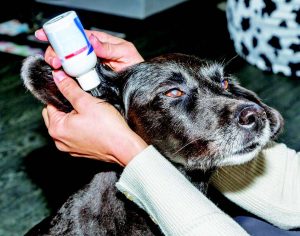Most of the time, we think that our pets are more rugged and hardier than we are, and that’s usually true. However, there will be days when your fur baby may get into more trouble than usual, and may have injuries that will require medical attention.
As it is with people, our pets do need to have first aid kits, since many of their lesser injuries can be treated with a proper kit, or treated at home.
STEP BY STEP: Assembling a homemade first aid kit for pets.
When assembling a first-aid kit, it’s important to think about how you’ll be using it. For practicality, we’re dividing the first aid kit into two: one for going around with your pet (this is practical, particularly for dogs), and an “upgrade” kit if you want to keep an expanded kit in your car or in your home.
It’s important to note that you may not need all of the kit items, but it pays to have an item there if you think or know that you’ll need it.
A Mobile Kit
Size: A mobile or portable first aid kit shouldn’t be too large. It can be as small as the size of a belt bag, or it can take up room in a backpack. You can also buy a dedicated bag for the first aid kit items.
Overview: The items in this kit are mostly focused on wounds, and for when your pet ends up eating something dangerous.

Assembly Checklist
First aid supplies (Be sure these are approved by your veterinarian first!)
Absorbent gauze, pads and squares – These are best for treating and protecting wounds. Always consider your pet when buying these items, particularly if they can entangle your pet.
Adhesive tapes (NOT band aids) – As most pets are furry, it’s important to buy adhesive tape that is not too sticky to prevent incidents in which the tape sticks to their fur and hurts them, making them wary of any bandage in the future. You can also use paper tape, if necessary.
Cotton balls and swabs – These are important for cleaning wounds, or apply medicine. Do remember to keep them in a clean or sterile container.
3% hydrogen peroxide to induce vomiting – We all know how pets can and will try to gnaw on or eat something they’re not supposed to put in their mouths. A 3% hydrogen peroxide solution will help induce vomiting. It’s important to note that you should only use this with directions and clearance from your veterinarian. If the vet says you shouldn’t use this on your pet, don’t.
Antibiotic ointment – Over-the-counter antibiotic ointments for the skin can take care of possible skin infections, or prevent them from happening until you can get home.
Cleaning wipes – Sterile wipes or alcohol wipes are a quick way to clean up an area which isn’t wounded or bleeding, or for sterilizing equipment and cleaning hands.

Saline eye solution – Eye cleaning solutions are very important for dogs who either have long fur on their faces, or have protruding eyes. If they look like their eyes are irritated, or if their eyes have excessive discharge due to dust or dirt in the area, it’s a good idea to use eye solutions.
Styptic powder or pencil – Styptic tools or items are used to stop bleeding. This may be useful for some types of wounds that are easy to clean, and are shallow.
Wound disinfectant – Iodine and other similar substances fall under wound disinfectants. Be careful when using this, as most of them will hurt; you should be prepared for your pet’s reaction.
Opthalmic ointments – If your pet has continuous medical issues with his or her eyes, then you should have ophthalmic ointments like Terramycin on hand.
Cortisone cream – If your pet is sensitive to skin irritants, cortisone cream is a must-have. However, you should clear its use with your vet, even if it is available over the counter.
Equipment
Disposable gloves – It may look dramatic, but it’s a good idea to treat open wounds or heavily bleeding ones while wearing gloves. Aside from preventing more bacteria from entering the wound, it can also protect you from bacteria or substances that could affect humans.
Tweezers – These work well with many other items. You can use them to pull out splinters, or use them to hold cotton balls when you’re wiping blood from wounds. You can even use them to remove foreign objects from ears or mouths BUT only if 1) you do so carefully and 2) the object is not too deep in the ear or mouth.
Turkey baster or oral syringe – You can use these tools to apply medicine, such as hydrogen peroxide to induce vomiting, or you can use them to irrigate irritated eyes with clean water.
Small towels – These are general-purpose items. You can use them to clean wounds, or remove dirt. You can also use it as part of a compress if necessary.
Small flashlight – If you think your dog or cat has swallowed something disagreeable, or they have a foreign object in their ear, a small flashlight can help. It is also important if it’s already towards night, or if you are in an area where there is little light.
Spare leash muzzle, collar, etc. – If you can, it’s a good idea to bring a spare leash, muzzle and/or collar, particularly if you know your dog has a low threshold of pain, or does not react well to it.
Pet-specific items – Some pets do have special needs – make sure to check with your vet if you need special added items to your kit.
A towel you can wrap your pet in – Sometimes you’ll need to restrain your dog or your cat; a towel that they can be wrapped in can help prevent them from hurting you.
This appeared in Animal Scene magazine’s November 2017 issue.






